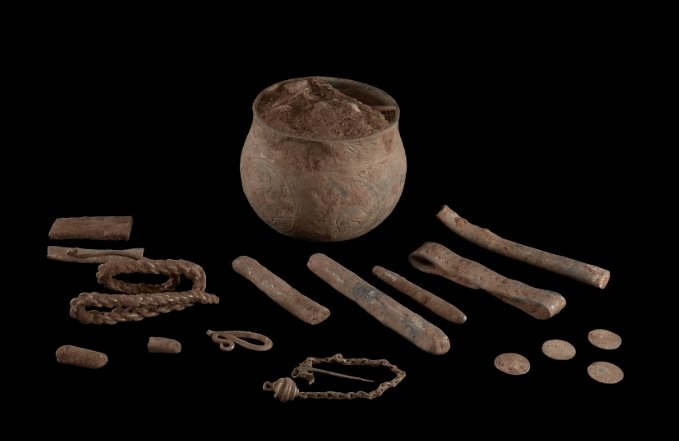In a remarkable archaeological find, seven Viking-era silver arm rings have been discovered in a field near Elsted, Denmark. The discovery was made by Gustav Bruunsgaard, a 22-year-old archaeology student from Aarhus University, using a metal detector. These arm rings, dating back to around 800 C.E., provide a fascinating glimpse into the Viking Age, revealing connections to regions as far as Russia, Ukraine, and the British Isles. The artifacts are now housed at the Moesgaard Museum in Aarhus, where they are being studied for their historical significance.
Unearthing the Past
The discovery of the Viking arm rings began as a routine metal detecting session for Gustav Bruunsgaard. While searching a field near Elsted, he stumbled upon a silver arm ring buried beneath the soil. Recognizing the historical importance of the site, Bruunsgaard returned with hopes of finding more artifacts. His persistence paid off when he unearthed six additional arm rings, each with unique designs and craftsmanship.
The arm rings, weighing over 500 grams in total, are believed to have been crafted in southern Scandinavia. Some of the designs, such as the tight coils, were popular in Russia and Ukraine before spreading to Nordic countries. This suggests a rich exchange of cultural and artistic ideas during the Viking Age. The discovery highlights the significance of Aarhus as a central hub in the Viking world, where trade and cultural interactions flourished.

The Moesgaard Museum, known for its extensive collection of Viking artifacts, has authenticated the arm rings and is conducting further research to understand their origins and historical context. The museum’s experts are excited about the potential insights these artifacts can provide into Viking society and trade networks.
The Significance of Silver
Silver played a crucial role in Viking society, serving as a measure of value and a means of payment. The arm rings, made of silver, were not only decorative but also symbolized the owner’s wealth and status. The discovery of these arm rings sheds light on the economic and social dynamics of the Viking Age, where silver was a key commodity.
The arm rings’ designs vary, with some featuring intricate patterns and others being plain and unadorned. This diversity in design reflects the wide range of influences and styles that were prevalent during the Viking Age. The presence of arm rings with designs common in England and Scandinavia further underscores the extensive trade networks that connected different regions.
Researchers at the Moesgaard Museum are particularly interested in the plain arm rings, which are considered rare. These unadorned pieces may provide new insights into the everyday lives of Vikings and their interactions with other cultures. The study of these artifacts continues to reveal the complexities of Viking society and its connections to the broader world.
A Window into Viking Culture
The discovery of the Viking arm rings offers a unique window into the cultural and artistic achievements of the Viking Age. The craftsmanship and design of the arm rings reflect the skills and creativity of Viking artisans. Each piece tells a story of cultural exchange, trade, and the movement of ideas across regions.
The Moesgaard Museum’s exhibition of the arm rings allows visitors to explore the rich history of the Viking Age. The museum’s experts are working to uncover more details about the origins and significance of these artifacts. The arm rings are a testament to the Vikings’ ability to create beautiful and functional objects that have endured through the centuries.
The discovery has also sparked renewed interest in Viking history and archaeology. It serves as a reminder of the importance of preserving and studying historical artifacts to gain a deeper understanding of our past. The arm rings are not just relics of a bygone era; they are a connection to the people and cultures that shaped the world we live in today.














